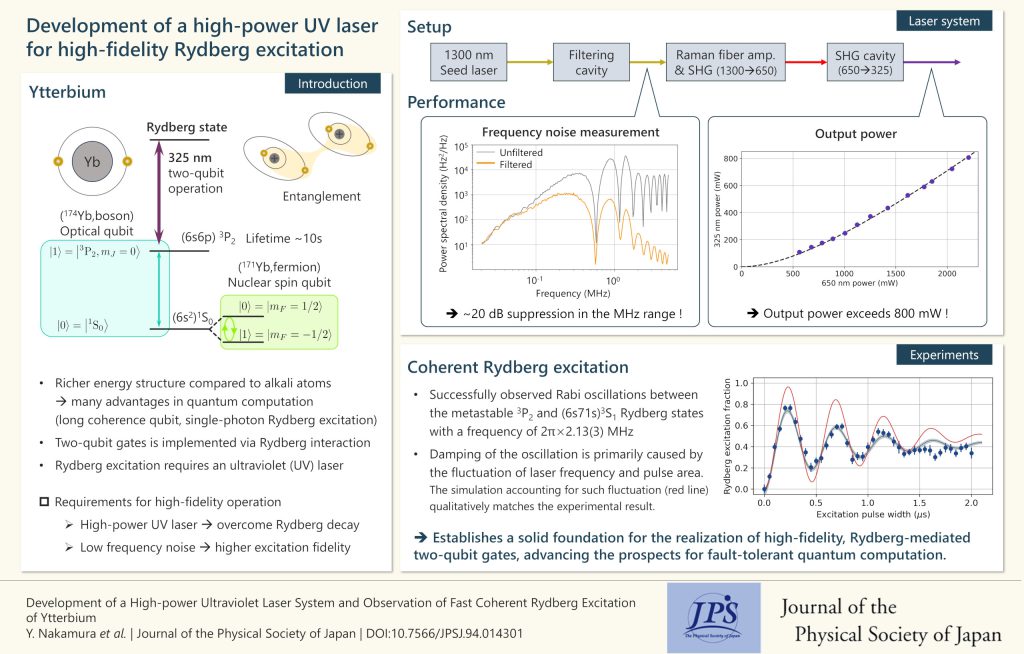Development of a High-Power UV Laser for High-Fidelity Rydberg Excitation
© The Physical Society of Japan
This article is on
Development of a High-power Ultraviolet Laser System and Observation of Fast Coherent Rydberg Excitation of Ytterbium
(JPSJ Editors' Choice)
J. Phys. Soc. Jpn.
94,
014301
(2025)
.
The development of a high-power, low-noise ultraviolet laser facilitates fast Rydberg excitation of single ytterbium atoms, which is a fundamental step towards achieving high-fidelity two-qubit gates.

Neutral atoms trapped in optical tweezer arrays have attracted significant interest as platforms for quantum computing. The implementation of two-qubit gates, which is crucial for universal quantum computation, is achieved through interactions between Rydberg atoms, where the valence electron of the atom is excited to an orbital with a large principal quantum number. Ytterbium (Yb), an alkaline earth-like atom, is a promising avenue for realizing high-fidelity two-qubit gates via single-photon Rydberg excitation from a metastable excited state. This approach addresses the limitations encountered with alkali atoms in earlier studies, such as scattering from the intermediate state during Rydberg excitation. To realize such Rydberg excitation, the development of a high-power ultraviolet (UV) laser is required.
In this study, we developed a high-power UV laser with a wavelength of 325 nm for the Rydberg excitation of single Yb atoms trapped in optical tweezer arrays. The laser system consists of a 1300-nm seed laser, a Raman fiber amplifier, and two-stage second-harmonic generation to convert the wavelength to 325 nm. A maximum output power exceeding 800 mW was achieved at 325 nm. This capability has the potential to enable 10 MHz-order fast Rydberg excitation, addressing Rydberg state decay, which is a primary limitation in the fidelity of two-qubit gates.
For high-fidelity quantum operations, it is crucial to manage laser phase noise. To address this, we incorporated a high-finesse Fabry-Pérot cavity between the seed laser and Raman fiber amplifier. The cavity has a finesse of 1.3×104 and a linewidth (full-width at half-maximum) of 230 kHz. We achieved phase noise suppression of approximately 20 dB in the MHz range, anticipating operation fidelities surpassing the threshold required for quantum error correction.
Using the developed UV laser, we demonstrated coherent excitation from the metastable (6s6p)³P₂ state to the (6s71s)³S₁ Rydberg state of ¹⁷⁴Yb. We successfully observed Rabi oscillations between these states with a Rabi frequency of 2π×2.13(3) MHz, marking an essential first step towards two-qubit operations in Yb atom arrays. This study establishes a solid foundation for the realization of high-fidelity Rydberg-mediated two-qubit gates, advancing the prospects of fault-tolerant quantum computation.
(Written by Y. Nakamura on behalf of all the authors)
Development of a High-power Ultraviolet Laser System and Observation of Fast Coherent Rydberg Excitation of Ytterbium
(JPSJ Editors' Choice)
J. Phys. Soc. Jpn.
94,
014301
(2025)
.
Share this topic
Fields
Related Articles
-
Towards a New Phase in Materials Science with Hyperordered Structures
Atomic and molecular physics
Cross-disciplinary physics and related areas of science and technology
Dielectric, optical, and other properties in condensed matter
Electron states in condensed matter
Mathematical methods, classical and quantum physics, relativity, gravitation, numerical simulation, computational modeling
Structure and mechanical and thermal properties in condensed matter
2023-5-1
A Special Topics edition of the Journal of the Physical Society of Japan features articles discussing recent advancements in hyperordered structures in materials, their applications, and the techniques for observing them.
-
Optical Tweezer Arrays with Ytterbium Atoms for Studying Quantum Phenomena
Atomic and molecular physics
2022-8-24
A neutral Rydberg atom tweezer array is a promising platform for quantum computation. In this study, featuring its metastable excited state, an array of single ytterbium atoms trapped in micro-optical tweezers was constructed. This overcomes many problems in conventional systems using alkali atoms.




